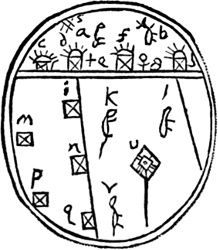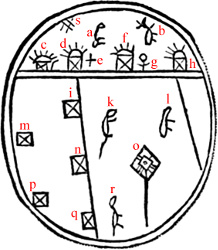A lost Pite or Lule Sámi drum, published by Johannes Schefferus in 1673
In chapter 11 of Lapponia from 1673, Johannes Schefferus depicts six Sámi drums from various regions. The first two he presents, he clearly knows only from written accounts and drawings. The other four he had physical access to, and as three of them still survive, we can tell that he made a fair representation of them. The fourth, labelled ‘D’, has since become lost, and from its unusual design, at least in the lower part, and that the symbols are drawn more like the drums reproduced from drawings than the surviving drums, one could suspect that this too was based on a simplified drawing and not a real drum. However, this suspicion is refuted both by Schefferus also providing a picture of the carved underside of the drum, and by Johan Peringskiöld (1654–1720) later making an independent drawing of the same drum, presumably around 1710. Unlike Olof Rudbeck who uncritically copied Schefferus’ material and forgeries alike in his inane Atlantica from 1679, Peringskiölds drawings are in some aspects closer to the originals than those of Schefferus for the surviving drums. They capture the proportions and relative placements of symbols better, but sometimes lack details present in Schefferus’ woodcuts, including several instances where Ernst Manker’s modern tracings confirm that Schefferus’ observations are correct and not just speculative embellishments.
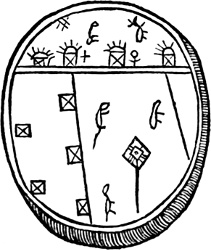
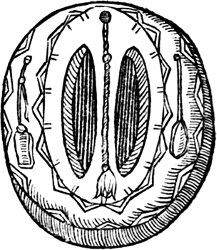
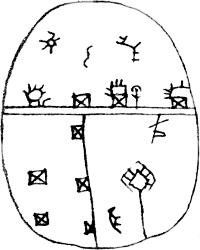
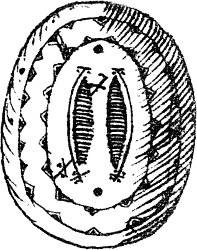
At first glance, the image in Schefferus’ woodcut looks so atypical that it almost defies classification. While the rhombic sun symbol makes is vaguely reminiscent of the Ume Sámi type, its isolation from other symbols including the lack of “beams” exending from three of its corners rules this out. It could conceivably be Lule Sámi, but taking the proportions in the Peringskiöld drawing into account makes Pite Sámi a possibility as well. The reason why the vertical dividing line which is markedly slanted and left of center in Schefferus whilst only slightly so in Peringskiöld seems to be due to the accidental positioning of the second deity in the upper field too far to the left, and that the line starts directly below that.
While still somewhat of an outlier, the decoration style is not entirely unparalleled in the surviving material. The upper field is quite typical, and also the sparse and abstract decoration of the lower field does have parallels when multiple types are included in the comparison.
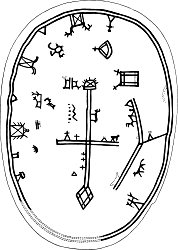
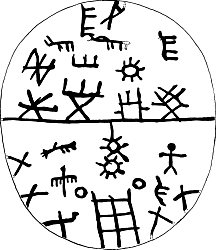
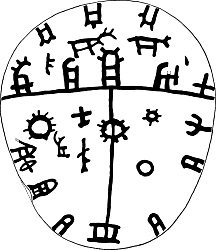
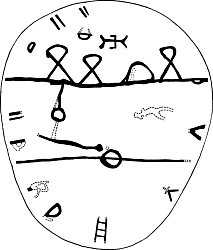
In the woodcut in Lapponia, scale bars are placed beside the reproductions of both sides of this drum and the much larger drum ‘C’ which is still extant. These indicate a length of 26 cm for the smaller drum and 42 cm for the larger, which is close to the 40 cm measured by Ernst Manker. There are no scale bars in Peringskiöld’s drawing, but all drums included there are drawn to the same scale; assuming 40 cm for drum ‘C’ there also yields 26 cm for drum ‘D’.
The interpretation of the symbols
Like drum ‘A’, the Lule Sámi drum described by Samuel Rheen and drum ‘B’, the Pite Sámi drum of Anund Eriksson, there is a brief list of interpretations covering most of the content of the drum, keyed to the individual symbols by letters on the woodcut drum illustration. For drum ‘C’ which is still extant, only the ladder-like structure at the bottom is labelled and explained; as “the underworld” for the entire structure, and “levels 1, 2 and 3” for the rungs of the ladder.
| a. | notat aves | denotes birds |
|---|---|---|
| b. | vulpes nigras | black foxes |
| c. | Tiuur, deum | Tiuur, a god |
| d. | Thoor, deum | Thor, a god |
| e. | malleum Thoronis | Thor’s hammer |
| f. | Stoorjunkare | the Grand Prince |
| g. | idolum ligneum | wooden idol |
| h. | famulum | servant |
| i. | ſtellam | star |
| k. | bovem | ox |
| l. | hircum | buck |
| m. | ſtellam | star |
| n. | lunam | moon |
| o. | Solam | Sun |
| p. | ſtellam | star |
| q. | itidem | ditto |
| r. | lupum | wolf |
| s. | Norias fiord. i.e. | Noria’s fjord, that is |
Comments on the entries
a: The plural term is surprising, as it refers to a single symbol. The shape of the symbol is ambiguous, and does not suggest a bird in any obvious way.
b: Again a plural term for a single symbol. The symbol is typical of how reindeer are drawn on other drums, making the stated interpretation unlikely.
c: This name of a deity is unparalleled, and presumably due to a transcription error from the source material. The most likely explanation is that the source had “tiener” both here and in h, but was misread as a name here.
d–h: These are all largely in line with other early interpretations, with two caveats: after Rheen and following him Schefferus used the term “Storjunker”, other observers noted that this term was only used in the Lule Sámi area. If this drum is not Lule Sámi but Pite Sámi, the use of this term is in need of an explanation. Either it could have a more widespread use contrary to these claims, or the interpretation could be “tainted” by Rheen’s, and not directly represent an authentic source. The other is that it is peculiar to have an image of a deity and a wooden idol presumably representing the same deity side by side.
i, m, p and q: These are all drawn in an identical way and given the same interpretation. However, it is quite unexpected to find stars here rather than in the upper, celestial field.
k and l: The first term used means “a bovine” or “a head of cattle” regardless of sex, while the second specifically refers to a male goat. Both are drawn as quadrupeds, but none of them have any distinguishing features; for the buck especially, the characteristic horns are usually included where such an interpretation is given.
n: This is drawn exactly like the symbols surrounding it which are interpreted as stars.
o: The letter is incomplete in the woodcut, looking more like a u, but it is clear that it must be intended as an o. Although the sun symbol tends to be circular or oval in Pite and Lule Sámi drums, this interpretation is obviously correct.
r: The symbol is drawn as a quadruped with a tail and no antlers, so there is no reason to doubt the interpretation.
s: This entry is odd in every way. In the woodcut, the letter is placed in the upper field beside a–h rather than the lower among i–r. The symbol it is placed beside is similar in shape and placement to those interpreted as stars in Rheen’s drawing. This clashes both by its own given interpretation and that four other symbols are interpreted as stars; however, it is important to bear in mind that Rheen’s drawing in general does not even attempt to reproduce the actual shape of the drum’s symbols. The interpretation text is clearly incomplete, as it abruptly ends with “i.e.” after an enigmatic Scandinavian place name that is not even Latinised. It is possible that this should be seen in the context of Tornæus’ account presented immediately before this pair of drums, which unlike other accounts alleges that the drums represent a kind of a map, with the Sámi world in the middle and neighbouring parts of Sweden and Norway at the southern and northern ends. Assuming north at the top, this would mean that the term refers to some fjord in Norway. However, neither this drum nor others do support such a geographical interpretation overall.
